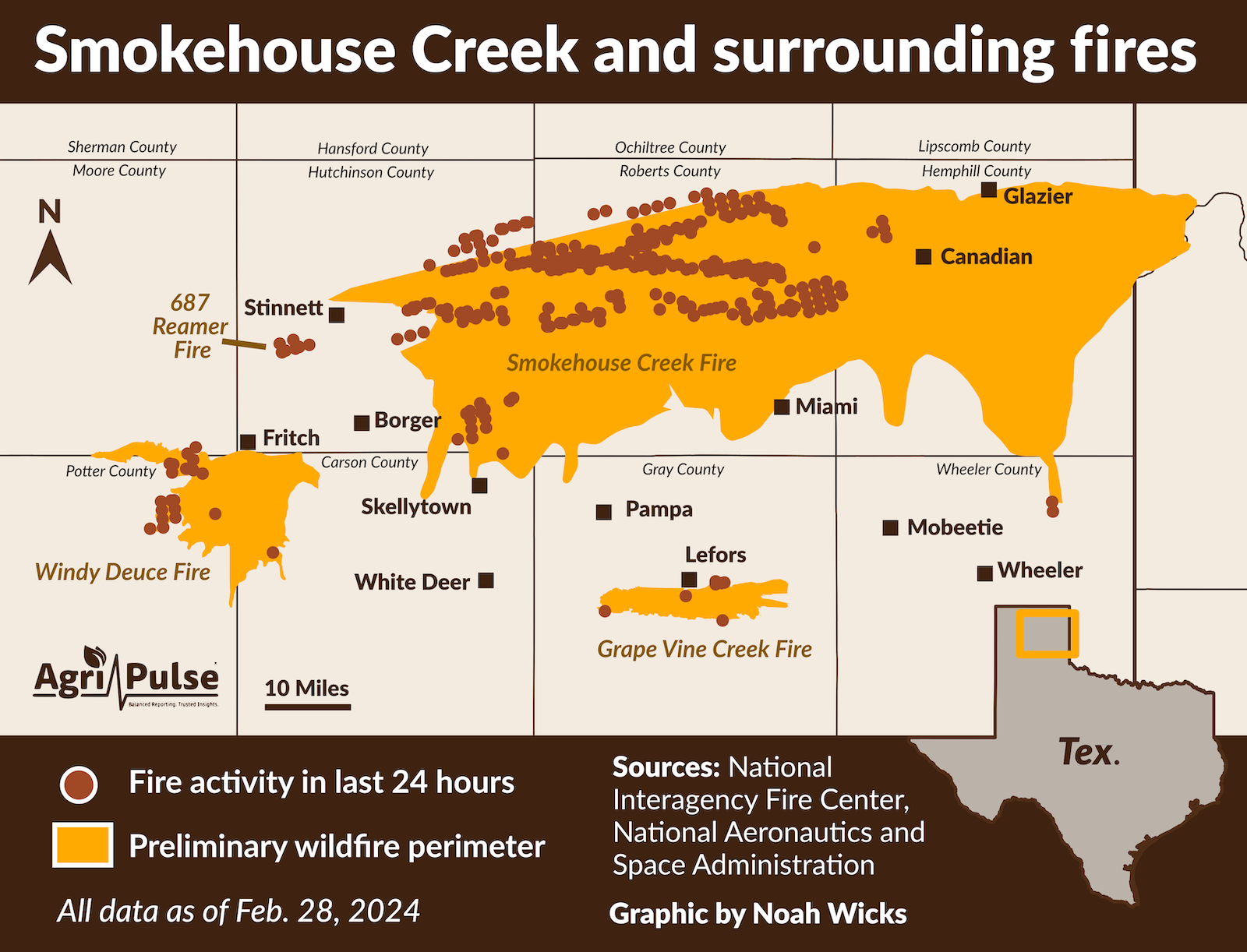A series of wildfires in the Texas panhandle has already scorched nearly 850,000 acres of land, impacting cattle producers and other residents in the region.
The start of the wildfires is currently under investigation, but five separate fires have forced evacuations and caused power outages. All told, the fire damage has now grown to the largest in the state’s history, according to Texas Ag Commissioner Sid Miller.
Erin O’Conner, public information officer with Texas A&M Forest Service, says dry conditions and wind speeds have accelerated the movement of the fires. As of Wednesday, conditions are favorable to work on containing the fires but will worsen as the weekend approaches.
“We do anticipate that we're going to be getting more dry and windy conditions Friday into the weekend. So we are encouraging residents and tourists, anyone that's coming into the area, to be very cautious,” said O’Conner.
She says firefighters and Forest Service crews will be working around the clock to contain the fires but it will take time to see improvement.
“With how large these fires are it'll probably be days maybe weeks until they get contained. That doesn't mean necessarily that they're actively burning and moving, but we will not leave a fire until we're totally 100% sure that it's not going to rekindle or move across containment lines,” said O’Conner.
It’s easy to be “in the know” about what’s happening in Washington, D.C. Sign up for a FREE month of Agri-Pulse news! Simply click here.
The largest fire, known as the Smokehouse Creek Fire, has blazed through 500,000 acres with a 0% containment rate. The next largest blaze, the Windy Deuce Fire located in Moore County Texas, is estimated to have impacted nearly 90,000 acres with a 25% containment rate; the Grapevine Creek Fire has impacted 30,000 acres and has a 60% containment rate.
Wheeler County judge and cattle rancher Pat McDowell says the speed of the fires has been devastating.
“It went across two counties in just a matter of hours,” he said.
Wheeler County sits just south of Hemphill County where the Smokehouse Creek fire has been ablaze. McDowell says the outer edges of the fires have been contained in Wheeler County, but many hay bales and brush piles are still smoking.
“The vast majority [of the burned area] is grass [and] cattle grazing pasture. It did encroach on our towns and small communities … that's where the focus of protection was,” said McDowell.
O’Conner says it is too early to tell what the loss and damage will be until the fires are fully contained.
“We can confirm that there is structure loss, but as to the type and the number we don't have that information at this time,” said O’Conner.
Texas Ag Commissioner Sid Miller says the wildfires have wiped out “thousands if not tens of thousands” head of cattle, although he says it is too early to tell what the actual damage is from the fires. Texas has over 11 million head of cattle and 88% of them reside in the panhandle where the fires are sweeping across the state.
To help producers during this time the department has set up livestock evacuation centers and has activated the hay hotline for individuals to donate money or hay to producers in need.
Miller says producers impacted by the fires should use the Agri-Stress Hotline, a mental health and suicide hotline for farmers in the state of Texas.
“My operators are all ag people, they have 300 hours of training with 168 different languages and they know the resources that can get somebody in agriculture help,” adding, “they will relay any USDA emergency loan programs I tell them about, or tell them about our programs at the Texas Department of Agriculture. [The operators] will link [producers] up to receive some mental health help.”
That number is 833-897-2474.
Zach Ducheneaux, administrator of USDA's Farm Service Agency, addressed the matter in conversations with producers gathered in Houston. He said staff in the area are preparing to administer emergency loans and other programs to soften the blow for affected producers.
“We encourage all of our producers to make sure that they're documenting losses, as painful as it is, because we need that documentation to be able to come in for the livestock that were lost,” he said.
This story was last updated at 5:00 p.m. EST on February 28.
For more news, go to Agri-Pulse.com.


